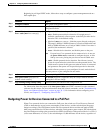
12-26
Catalyst 2960 and 2960-S Switch Software Configuration Guide
OL-8603-09
Chapter 12 Configuring Interface Characteristics
Configuring Ethernet Interfaces
To return to the default setting, use the media-type auto interface or the no media-type interface
configuration commands.
e switch configures both types to autonegotiate speed and duplex (the default). If you configure
auto-select, you cannot configure the speed and duplex interface configuration commands.
When the switch powers on or when you enable a dual-purpose uplink port through the shutdown and
the no shutdown interface configuration commands, the switch gives preference to the SFP module
interface. In all other situations, the switch selects the active link based on which type first links up.
The switch operates with 100BASE-x (where -x is -BX, -FX-FE, -LX) SFP modules as follows:
• When the 100BASE -x SFP module is inserted into the module slot and there is no link on the RJ-45
side, the switch disables the RJ-45 interface and selects the SFP module interface. This is the
behavior even if there is no cable connected and if there is no link on the SFP module side.
• When the 100BASE-x SFP module is inserted and there is a link on the RJ-45 side, the switch
continues with that link. If the link goes down, the switch disables the RJ-45 side and selects the
SFP module interface.
• When the 100BASE-x SFP module is removed, the switch again dynamically selects the type
(auto-select) and re-enables the RJ-45 side.
The switch does not have this behavior with 100BASE-FX-GE SFP modules.
Configuring Interface Speed and Duplex Mode
Depending on the supported port types, Ethernet interfaces on the switch operate at 10, 100, or 1000
Mb/s, or 10,000 Mb/s and in either full- or half-duplex mode. In full-duplex mode, two stations can send
and receive traffic at the same time. Normally, 10-Mb/s ports operate in half-duplex mode, which means
that stations can either receive or send traffic.
Switch models can include combinations of Fast Ethernet (10/100-Mb/s) ports, Gigabit Ethernet
(10/100/1000-Mb/s) ports, 10-Gigabit module ports, and small form-factor pluggable (SFP) module
slots supporting SFP modules.
These sections describe how to configure the interface speed and duplex mode:
• Speed and Duplex Configuration Guidelines, page 12-26
• Setting the Interface Speed and Duplex Parameters, page 12-27
Speed and Duplex Configuration Guidelines
When configuring an interface speed and duplex mode, note these guidelines:
• Fast Ethernet (10/100-Mb/s) ports support all speed and duplex options.
• Gigabit Ethernet (10/100/1000-Mb/s) ports support all speed options and all duplex options (auto,
half, and full). However, Gigabit Ethernet ports operating at 1000 Mb/s do not support half-duplex
mode.
• For SFP module ports, the speed and duplex CLI options change depending on the SFP module type:
–
The 1000BASE-x (where -x is -BX, -CWDM, -LX, -SX, and -ZX) SFP module ports support
the nonegotiate keyword in the speed interface configuration command. Duplex options are not
supported.
–
The 1000BASE-T SFP module ports support the same speed and duplex options as the
10/100/1000-Mb/s ports.


















